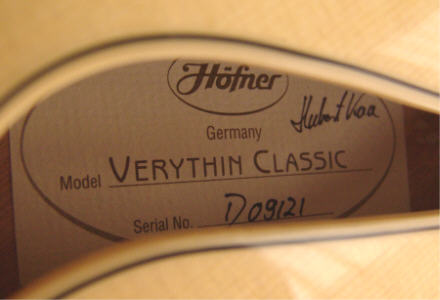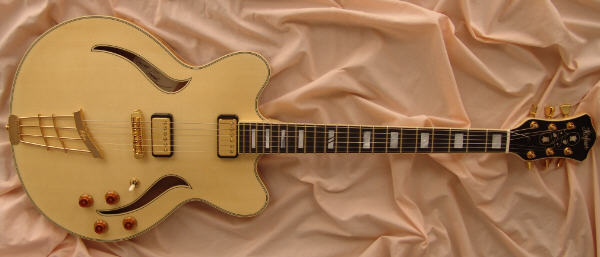

Yes, this is a current Hofner model being featured on the Vintage Hofner website! However, I believe that the new Hofners may well be of interest to visitors to this site, both for comparison with the 1960's guitars, and maybe as a strong possibility for purchase. Featuring a new Hofner in this way is also complimentary to the New Hofner section of the website which has recently been added.
I have owned a 1963 Verithin for several years, and although enjoying the comfortable playing position due to the guitar's very thin body, I have always been a little disappointed with the performance of the electrics. No major problems with the strength of the pickups, but the four control knob arrangement without selector switch was certainly not one of Hofner's better ideas. To say that control with this arrangement is vague is an understatement, particularly on 40 year old guitars who's electrical components are now just a little "past-it". The rectangular control consul fitted on earlier guitars is a far more positive and workmanlike arrangement (if one can remember which of the switches and volume controls serve which pickup!). I believe that sometime during the 4-knob period, Bert Weedon changed his allegiance from Hofner to Guild because he just couldn't put up with the Hofner electrics any longer. It is a very different matter with the new Verythin. I think that Bert may well have stuck to playing Hofners if this beauty had been around in those days!

The new Verythin is currently produced in three variants - the "Standard", the "Classic" as this one being featured, and the "Vintage". The Classic version is the deluxe version of the Standard which as well as a different body top (spruce rather than flame maple), different shaped sound holes, ebony fingerboard, and gold plating throughout, does have the "Clear Contour" control on the tone pots (see later). Having said that, the Verythin Standard is probably closer to the old Verithin, particularly if it has the beautiful red finish option. The "Vintage" model has the same construction details as the "Classic", but utilises the rectangular Hofner control consul for the electrics, and is finished in "antique violin" varnish. When it gets down to it, the "Vintage" Verythin is probably the least like a 1960's vintage Verithin of the three modern variants!
Apparently, Hofner have changed the name from VERITHIN to VERYTHIN because the old name was given to the guitar by the Selmer London company, and it would seem that Hofner wish to avoid legal complications.
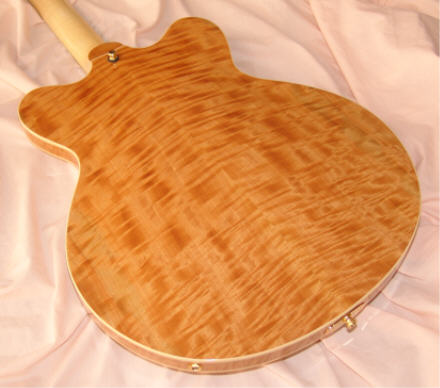
The construction of the new Classic is laminated spruce body top and book-matched flame laminated maple back. The sides are also flame maple, and unlike the original Verythin, there is a centre spruce block inside the body (as with the Gibson 335). This has the effect of reducing feedback, and it would seem increasing the sustain of the guitar. Certainly my new Verythin sustains better than any other guitar that I can remember playing, including a ES335 which I sold many years ago. Multiple binding/purfling surrounds both top and bottom edges of the body, as well as the "slash" shaped sound holes.
The neck is made from a single piece of flame maple, and this is capped with an ebony fingerboard, again bound. A nice touch is the maple veneer on the rear of the headstock which covers the joints where wings have been added to the neck timber to provide sufficient width for the headstock. The joints are usually very obvious on an old Hofner.
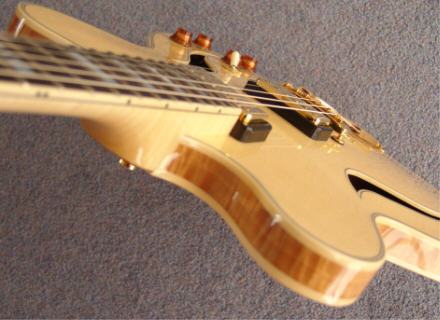
Block fret markers made of Mother of Pearl are used, with a split three piece
block at the 12th fret. These and the dark smooth ebony fingerboard add to the
luxurious feel of the guitar. Due to the twin cutaways, the shallow heel, and
the fact that the neck/body joint is at the 18th fret, access to the top
registers of the guitar is excellent.
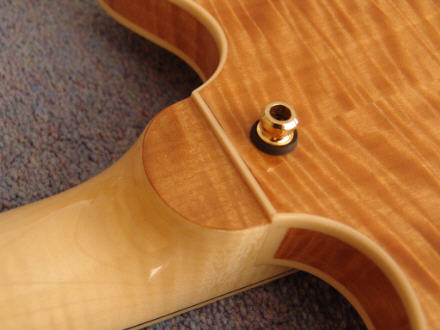
Twin mini humbucking pickups are fitted, and these provide a powerful and wide tone range. There are no harsh tones on this guitar, making it an ideal blues player's instrument. The old Hofner method of retaining and adjusting the pickups has been adopted - the four horizontal grub screws mounted in the plastic surrounds which grip the sides of the pickup case.
Controls are almost conventional - a volume and tone control for each pickup, plus three-way selector switch - but not quite. Hofner's "Clear Contour" control is incorporated in each tone control. Positions 1 to 8 give you the full twin coil sound. Above 8, the Contour control switches in with a simulated single coil style sound. It all adds up to a versatile range of sounds that this guitar can produce. If you do try out one of these guitars in a retail store, make sure that you try the tone control in several positions, rather than just flicking it up to 10 and then wondering why it doesn't sound like a 335.
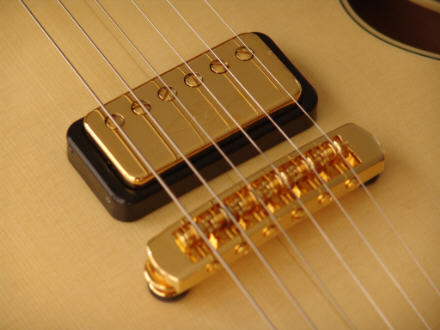
Hardware is gold plated, and I believe that it is made in Germany by Schaller. The bridge is fully adjustable for intonation and overall height. In addition, a string spacing adjustment facility is built into the bridge. A Lyre-style tailpiece is fitted, just like the old days, although a more fashionable stop-tailpiece is fitted to the "Standard" Verythin.
Schaller enclosed tuners with metal buttons are fitted to the headstock, and these are, of course, smooth efficient units. The traditional Hofner "Lily" inlays are also cut into the ebony headstock facia, utilising mother of pearl and a script Hofner logo is also inlaid at the top. There is no zero fret.
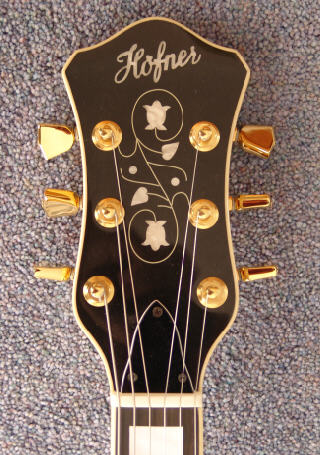
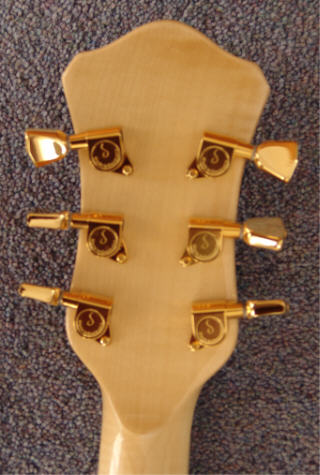
The guitar comes complete with a very impressive hard case, which tends to collect almost as much admiration as the guitar itself when examined by fellow guitarists. There is even a built in humidifier and humidity gauge built into the case, which I have to say that I have never seen before with any other make of guitar.
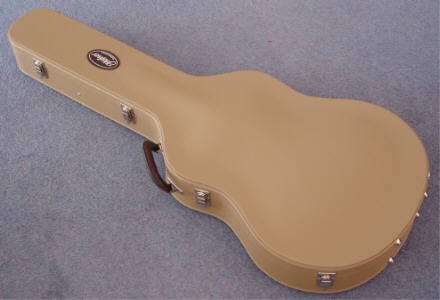
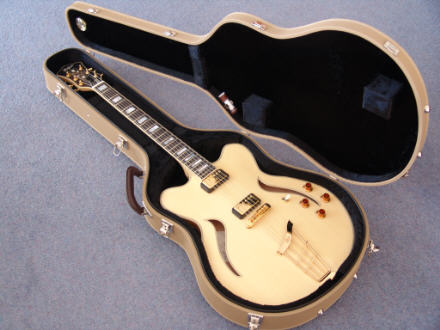
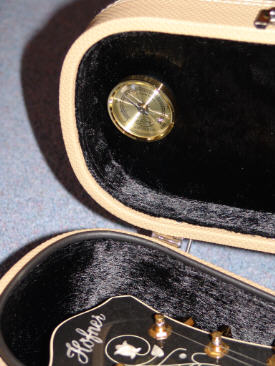
My conclusions about the current Hofners? Well, they are of excellent quality but also they do feel like handmade guitars, which of course they essentially are. They are very individualistic, and I think that it is possible to get a buzz from knowing that one is playing something different to the tens of thousands of other manufacturers' guitars that are now being built by computers. The fact that the Hofner luthier has signed his name on the model label inside the guitar says a lot. There is actually a picture of Hubert Kaa, the guy who made my guitar on the Factory Pages elsewhere on the website. And what about that case...............!!
